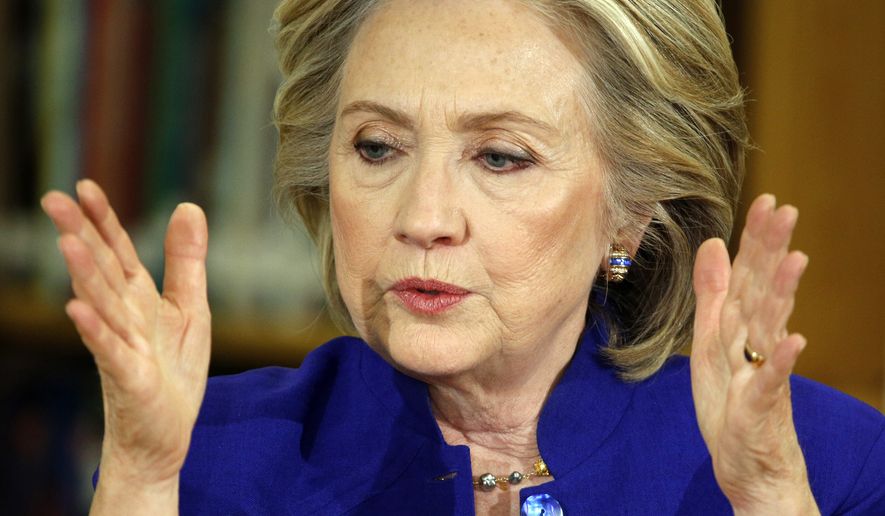OPINION:
ANALYSIS/OPINION:
By the time you read this column, it will have been more than 38,000 minutes since Hillary Rodham Clinton took a question from the media. That’s 26 days.
While this is certainly an insight into how she would operate as president, Mrs. Clinton is just a candidate now, which means she’s supposed to be put through the paces, answering any and all questions so voters can assess her qualifications for the presidency.
Republican candidates have faced ridiculous queries: Do you believe in evolution? Would you attend a gay wedding? Do you think President Obama “hates” America? Sure, that’s just the liberal mainstream media doing what they do, but all’s fair in love, war — and politics.
Last week, the big topic was Iraq. Jeb Bush said he would have invaded, just as his brother did in 2003, but later said he misheard the question, missing the crucial opening clause: “Knowing what we know today ….”
Candidate after candidate, announced and otherwise, were asked how they would have handled Iraq. They all answered. Why? Because it’s an important question, and Americans have a right to know how they would have handled the crisis.
SEE ALSO: Nancy Pelosi on Hillary Clinton’s Iraq vote: ‘That was then, this is now’
But Mrs. Clinton hasn’t answered the question. And she should. While Mr. Bush was governor of Florida at the time of the 2002 vote, she was a senator and was one of 29 Democrats who supported the resolution, which passed Oct. 11 by a 77-23 vote.
Joe Biden and John Kerry, both senators at the time, supported the measure. Mrs. Clinton’s New York colleague Charles Schumer said yes. So did Sen. Dianne Feinstein of California. Heck, even Senate Democratic Leader Harry Reid of Nevada voted for the resolution.
The day before the vote, Mrs. Clinton delivered a passionate — and lengthy — speech in support of the war bill.
“I believe the facts that have brought us to this fateful vote are not in doubt,” she said on the Senate floor. “Saddam Hussein is a tyrant who has tortured and killed his own people, even his own family members, to maintain his iron grip on power. He used chemical weapons on Iraqi Kurds and on Iranians, killing over 20,000 people.”
She laid out a detailed case for why America needed to step in, singing the praises of George W. Bush’s father. “In 1991, Saddam Hussein invaded and occupied Kuwait, losing the support of the United States. The first President Bush assembled a global coalition, including many Arab states, and threw Saddam out after 43 days of bombing and a hundred hours of ground operations.”
She pointed out that after that war, “the United Nations imposed a number of requirements on Iraq, among them disarmament of all weapons of mass destruction, stocks used to make such weapons, and laboratories necessary to do the work.” And she noted that everyone knew Saddam had WMDs: “The [U.N.] inspectors found and destroyed far more weapons of mass destruction capability than were destroyed in the Gulf War, including thousands of chemical weapons, large volumes of chemical and biological stocks, a number of missiles and warheads, a major lab equipped to produce anthrax and other bioweapons, as well as substantial nuclear facilities.”
She expressed support for her husband’s decision in 1998 to push for “regime change,” and ripped the U.N. for putting limits on its inspections. And she went on and on about Saddam’s WMD stockpile, saying he held so many secret sites that “were huge compounds well-suited to hold weapons labs, stocks.”
Mrs. Clinton declared that Saddam, “left unchecked … will continue to increase his capacity to wage biological and chemical warfare, and will keep trying to develop nuclear weapons. Should he succeed in that endeavor, he could alter the political and security landscape of the Middle East, which as we know all too well affects American security.”
But perhaps she didn’t fully believe the intelligence, the top-secret briefings. Wait, she did: “Now this much is undisputed.” Undisputed. Saddam had WMDs, had used them against his own people, was a serious threat to the world. Or so she said.
Of course, years later, she took it all back. In “Hard Choices,” Mrs. Clinton apologized. “I thought I had acted in good faith and made the best decision I could with the information I had. And I wasn’t alone in getting it wrong. But I still got it wrong,” she wrote — in 2014.
But that’s the job of a president, of a senator. Elected officials must assess the facts as they exist at the time duty calls — and act. They can reassess and alter their views, but the vote still stands, as does the decision.
What’s most interesting: George W. Bush made dozens of hard choices as president, hence the name of his book, “Decision Points.” Mrs. Clinton’s only really big decision as a back-bench senator was on Iraq — she said then that it was “probably the hardest decision I have ever had to make.” By her own admission, she blew it.
In that floor speech, she closed with this: “It is with conviction that I support this resolution as being in the best interests of our nation. She said, “It is a vote that says clearly to Saddam Hussein — this is your last chance. Disarm or be disarmed.”
Now — or soon, anyway — she’ll have to explain how she got it so wrong. If she ever takes another question from the media.
⦁ Joseph Curl covered the White House and politics for a decade for The Washington Times. He can be reached at josephcurl@gmail.com and on Twitter @josephcurl.




Please read our comment policy before commenting.